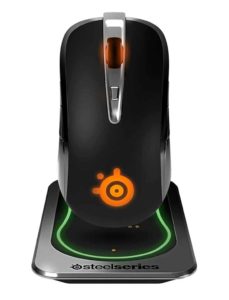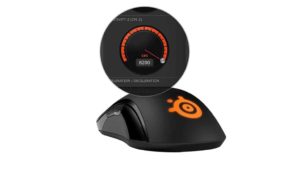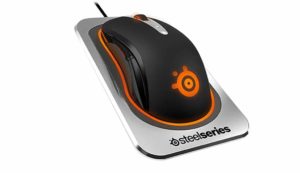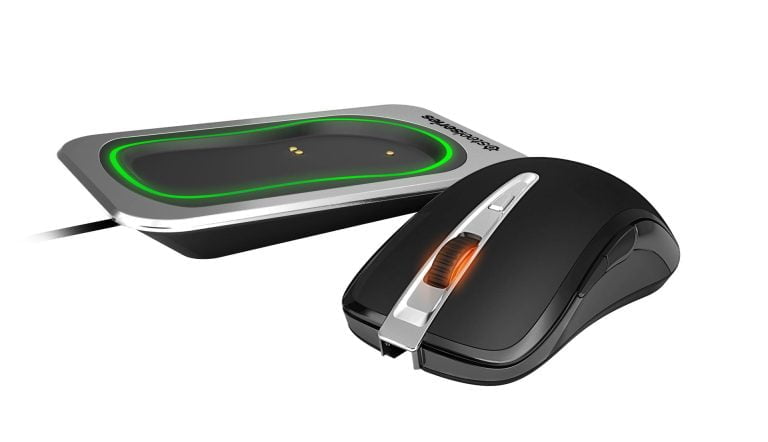Your Gaming Sensei Will Never Betray You
At a first glance, the mouse is a no-frills device suitable for standard typing jobs at the office, but that’s not the case. Sensei Wireless is a premium gaming mouse suitable for ambidextrous or left- handed users. I have to admit that there is a difference between this mouse and the ergonomic mice shaped to fit either the left or the right hand, but you may rest assured Sensei is very comfortable for prolonged use.
- Connectivity Technology: Wireless, wired - USB, 2.4 GHz
- Cutting edge laser sensor - Superior Performance
- Exact features - Aim, Accel, Lift, Snapping
- Illumination color, intensity and pulsation effects
- SteelSeries switches >30 million clicks lifecycle
- 8 programmable buttons (incl. CPI)
- Illuminated aluminum charging base
If you want to find out more details about the SteelSeries Sensei Wireless Gaming Mouse before buying it, read the review below.
Basic Specifics

The laser sensor is excellent and the software offers a variety of configuration options. It allows you to set profiles for the games you play. You can easily switch between MOBA and FPS profiles, for example.
On the other hand, the mouse lacks some important configuration options. It is lightweight, and some hardcore gamers will be unhappy with the absence of a weight adjustment feature. What’s more, while in FPS you don’t need so many buttons, that’s not valid for other gaming genres. That’s why some gamers wish the mouse had more buttons. Still, the button, located at the top of the mouse can be used to cycle through the DPI settings, or you can re-program it if you want.
The Sensei wireless is a symmetrical mouse that has a rather straightforward design. Do you remember the good old times when you used an optical symmetrical mouse? I bet that if you are a 90s kid, you grew up using a symmetrical mouse. As the saying goes: “Old habits die hard” so you will definitely appreciate Sensei’s non-obtrusive, ambidextrous design.
When you take the mouse out of the box, you will get the impression that it looks and feels sturdy. The top and sides are made of rubberized plastic that adds to your comfort. The SteelSeries’ logo on the top of the mouse illuminates and you can adjust the color and intensity of the illumination via the software.
Size
The mouse’s dimensions are 1.61×2.72x 5.08”. It weighs 4.23 ounces or 120g. It is considerably heavier than its predecessor and it takes a few days to get used to it. One of the features that impressed me most was the metallic charging dock. It has an integrated wireless receiver, which considerably reduces mouse’s portability, but don’t jump to conclusions before you find out the positive aspects of that design solution. The charging dock is heavy enough, so it will not slide around your desk, not to mention it is perfectly crafted for the mouse. The illuminating ring surrounding the dock can also be programmed via the software.
Layout
As I mentioned earlier, the mouse has a bare bones design. It seems that the SteelSeries is playing it safe as the model has just one CPI toggle on the top and two buttons on each side.
As for the buttons, they are placed very conveniently. Users have a total of eight programmable buttons at their disposal. In addition to the four thumb buttons and the two on each side of the mouse, the Sensei Wireless also possesses a button for DPI sensitivity adjustment as well as a clickable scroll wheel.
If you have ever used an ambidextrous mouse, you must be well-aware that the nondominant thumb buttons need to be deactivated. However, with Sensei Wireless, you will not encounter any issues of this kind. The buttons are small and easy to click, but they do not get in the way of the ring finger and the pinky. The dominant thumb buttons are well suited for frequent commands although it is a good idea to assign minor commands to nondominant buttons. If you are a WoW fan, you can assign accessing the quest log in World of Warcraft to the nondominant buttons.
As for the DPI switch, it offers two options, which would be sufficient for First Person Shooter enthusiasts.
Responsiveness and Sensor
The mouse comes with a high sensitivity laser sensor and an adjustable DPI that reaches the staggering 8200. The 1000 Hz polling rate and the 1ms response rate make the mouse as responsive as its wired counterparts.
I will never get tired of saying that a few years ago there was nothing that would convince me to replace my corded rodent with a wireless one, but the release of Sensei Wireless and similar products made me reconsider my firm decision. The 2.4 GHz wireless connection offers nearly a lag-free performance. The mouse acceleration is turned on by default but you can disable it. It all depends on your preferences. I have heard pro gamers swearing by it, as well as others who just want perfect pixel-by-pixel movement.
Wired or Wireless?

If you are approaching your 30s, you must remember that a decade ago “wireless” and “premium gaming mouse” were two mutually excessive terms. It seems the Sensei Wireless mouse is here to prove that a high-end wireless gaming mouse is not an oxymoron anymore. Now, let’s dig deeper into its wired and wireless capabilities.
The biggest concern of those who stick to using their corded rodents is the input lag. I have to tell you that in my tests the mouse performed better in wired mode although it scored pretty good in wireless mode, too.
According to manufacturer’s manual, the battery life is 20 hours. If you do not use the mouse for more than 15 minutes, the power saving mode is triggered. I have to admit that in this field the Sensei Wireless exceeded my expectations. I noticed hardly any lags even when the battery was almost drained.
It takes approximately 3.5 hours for the battery to get fully charged. Meanwhile, you can plug in the USB cable and continue playing. Here are a few small yet important details you will not find in the user manual. You have to be very careful with the connector. It locks into place when you attach it to the mouse. When you want to remove it, you have to push the unlocking button otherwise you risk causing a permanent damage. What is the big deal?-some of you would ask? The trick is that the connector has a proprietary shape and finding an exact replacement can be next to impossible. Of course, you can use a mini USB cable, but it’s not the best solution.
Software
The mouse is a plug-and-play device, but to be able to use the full range of functionalities it offers, you have to make the necessary settings via the customization dashboard. The mouse supports the SteelSeries Engine 3 software compatible with Mac and Windows OS. The software offers unlimited cloud storage for profiles and allows you to configure the mouse in a manner that it meets your gaming style. All configuration options are available in one window.
It seems the rule “Keep it simple” applies not only to the design but also to the software. Everything is crammed in one window. The programming and selection of macros and the buttons’ actions, in general, can be adjusted from the left side of the panel. You can also configure the delays between keystrokes but keep in mind that the macro recorder will not register mouse’s movements.
In the middle of the application window, you will find the options for adjusting the illumination color and effects.
The right portion of the application window houses the most important features– the acceleration and deceleration sensitivity, the polling rate, the CPI programming, the sleep timer and battery saving settings to name a few.
The macro commands can be stored in unlimited profiles and you have them available in the cloud. The only inconvenience is that you will not be able to access them unless you install the software on each computer you use. In this respect, the availability of on-board storage would be nice, but the practical advantages of the cloud storage are undeniable. Believe it or not, it took me 15 minutes to adjust the settings to my liking.
Frankly, the battery save mode is a two-bladed knife. It can prolong the battery life to 20 hours, but I found out that sometimes the mouse needed 1 minute to reestablish the wireless connection when being woken. That’s not really a con, but still, decide for yourself if it would be a bother.
Wrap Up

To summarize, Sensei Wireless delivers as promised. It reacts well on almost all surfaces, even stone and glass, but I don’t advise you to go to such extremes. You’d better invest in a good mousepad. It not only reduces the risk of scratches and damages, but it also increases the mouse’s accuracy.
Sensei Wireless is undoubtedly a mouse, designed with gaming in mind. It is a niche product that meets the expectations of pro gamers. It is also the most vivid commitment to quality Sensei has demonstrated so far. So, if you are looking for a device with consistent performance regardless of the preferred gaming genre, don’t hesitate to give SteelSeries Sensei Wireless gaming mouse a chance.
- Connectivity Technology: Wireless, wired - USB, 2.4 GHz
- Cutting edge laser sensor - Superior Performance
- Exact features - Aim, Accel, Lift, Snapping
- Illumination color, intensity and pulsation effects
- SteelSeries switches >30 million clicks lifecycle
- 8 programmable buttons (incl. CPI)
- Illuminated aluminum charging base


